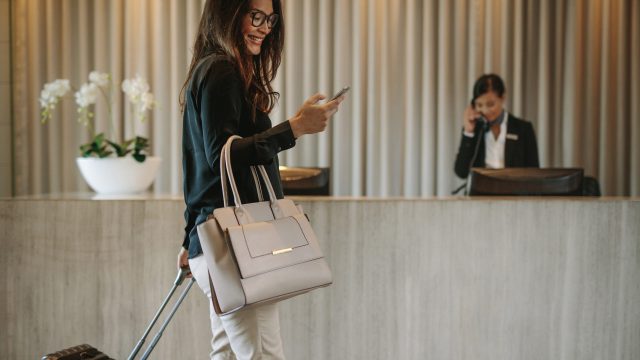The pandemic has changed travelers, and hotels need to adjust
2022-01-24LOS ANGELES — As the Americas Lodging Investment Summit gets underway, a report released Monday from the American Hotel and Lodging Association suggests many of the hot topics at the conference will remain the same as six months ago.
The 2022 State of the Hotel Industry indicates optimism for a continued recovery, although uncertainty over its exact trajectory. Key areas of concern are staffing and the return of business travel.
The issues and outlook are little changed from July, when the last ALIS was held. Back then, the Covid-19 delta variant dampened optimism built up over the first half of 2021.
The report also calls for hotels to ramp up efforts to adjust to how travel and travelers have changed, in some cases permanently, since Covid-19’s arrival.
“The next phase of recovery will be uneven, potentially volatile. But one thing remains certain: 2022 is the year of the ‘new traveler,'” states the AHLA report, which was produced in conjunction with Accenture and draws on numerous recent travel surveys and studies.
Covid-19 variants create volatility
While travel continues to rebound and hotel revenue with it, a key lesson of 2021 is how unpredictable Covid-19 and its impacts can be.
“Future variants will create volatility in both the return of leisure and business travel, and tens of billions of dollars connected to meetings and events spending,” the report states.
Looking ahead with analysis from STR, a full recovery remains several years away, and current conditions indicate steady growth should not be expected until mid-2022 at the earliest, according to the report.
In 2022 hotel occupancy and room revenue are predicted to approach 2019 figures, but the projections for ancillary revenue, including food and beverage and meeting space, are less bright. In 2019, ancillary revenue totaled $48 billion for the industry. Analysts see a little more than half of meetings and events returning in 2022.
Adjusting for projected inflation, a true recovery for the industry will not occur until 2025, according to an STR and Tourism Economics.
Staffing woes linger
Hotels have struggled to rehire as they reopened and ramped up operations following initial pandemic lockdowns, and recruitment issues appear likely to continue.
A survey AHLA conducted in October revealed 94% of hotels reported being understaffed, and 47% said they were “severely understaffed.” Nearly all, 96%, said they were actively hiring but were unable to fill open positions.
“While nearly every industry experienced labor shortages last year, shortages were particularly intense in hotels because of both pandemic layoffs and a wave of people leaving voluntarily, often for opportunities in other industries,” the report states.
Still, progress is anticipated in 2022 as the industry is expected to invest in recruitment and retention. Hotels finished 2021 at 77% of their 2019 employment levels, according to the report, and are expected to end the year at 93% of 2019 levels.
Business travel lags
Leisure travel has driven the recovery, and that continues into 2022 as the return of business travel remains stifled by Covid-19 variants and accompanying restrictions.
Current forecasts indicate 58% of meetings and events will return in 2022 and business travel overall will remain down roughly 20% from 2019, according to the report, but the impacts of omicron are still not fully understood.
“While business travel demand will lag that of leisure travel, it is not, as some have argued, a thing of the past,” the report argues. “This is especially true in the United States, the world’s most popular business travel destination.”
According to an analysis by Kalibri Labs, by the third quarter of 2022 business travel will reach 80% of 2019 levels, while a full recovery is not predicted until 2024.
Yet, the revenue share forecast remains flipped. Business travel drove 53% of hotel room revenue in 2019, but is projected to make up 44% of room revenue in 2022.
‘The new traveler’
With an eye on the lingering issues weighing down the pace of recovery and permanent alterations to the customer mindset, the AHLA report suggests it is time for the industry to adapt to the “new traveler.”
“While a true recovery to pre-pandemic levels is still several years away, the more that hotels understand, prepare for and respond to the needs of the new traveler, the brighter the future looks for an industry that is vital to the American economy,” the report states. “In 2022, rebuilding the workforce, doubling down on sustainability, and reimagining loyalty will be key areas for hotels that want to be relevant to the new traveler.”
The report highlights “bleisure” (blending business and leisure travel) as a category that has “exploded,” and also points to digital nomads as an area of growth thanks to spreading work-from-anywhere policies.
“We might also expect a blurring of these segments as bleisure travelers’ experiences push them to more permanent digital nomad style ways of working,” the report states.
Additionally, leisure travelers have fundamentally changed their purchasing perspective.
“Instead of focusing primarily on price and quality in making purchasing decisions, these new travelers are motivated to purchase by factors including health and safety, ease and convenience, care, trust, and reputation,” according to the report.
As the revenue balance remains tilted toward leisure travel, amenities such as spas, pools, and access to entertainment and attractions take on more importance compared with business traveler-focused perks such as laundry service, gyms and business centers. Loyalty programs will be redesigned to address the shift toward leisure travel.
“The reality is that loyalty schemes based on frequency of travel are out of step with the behaviors of the new traveler and with a suppressed demand environment,” the report states. “And even as demand picks up in the coming months and years, the mix of business and leisure travel will be permanently changed, and loyalty programs should align with travelers’ current behaviors to truly engage them.”
Courtesy of Travel Weekly


